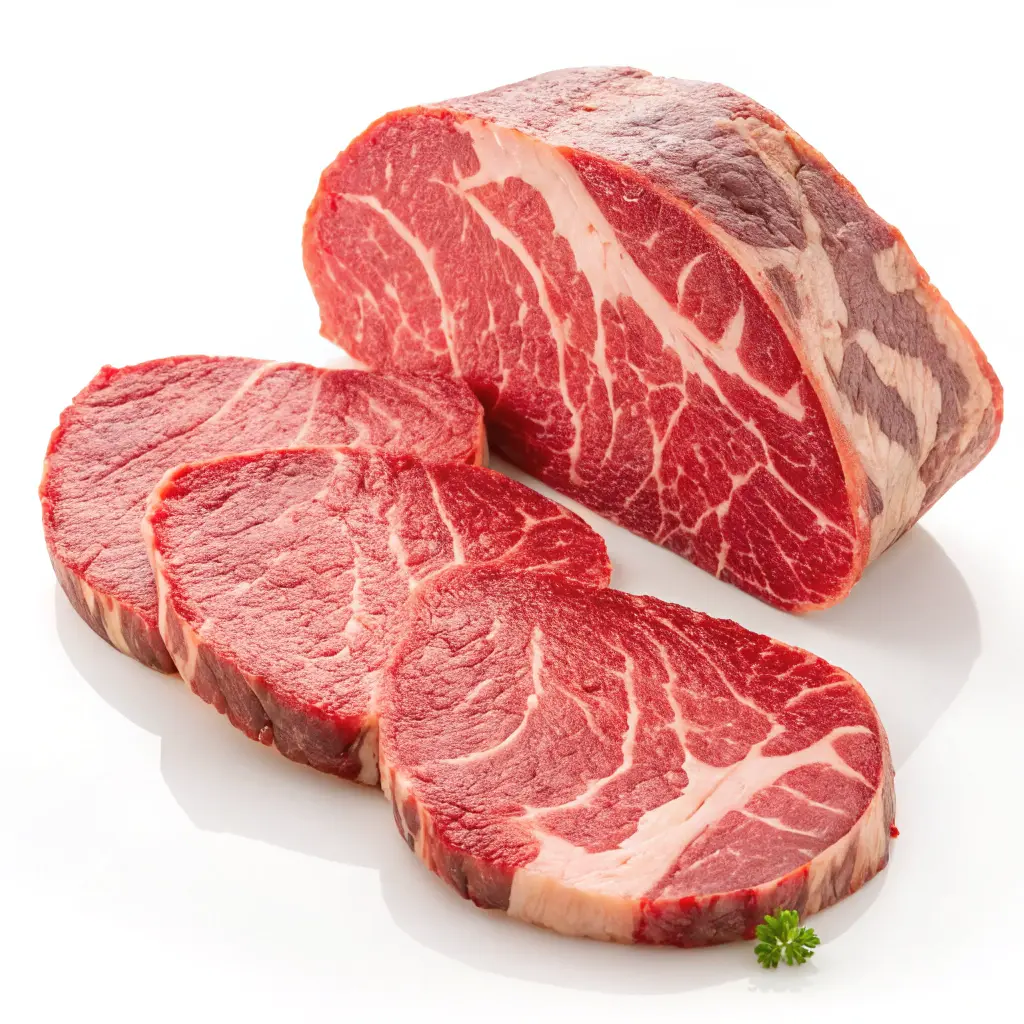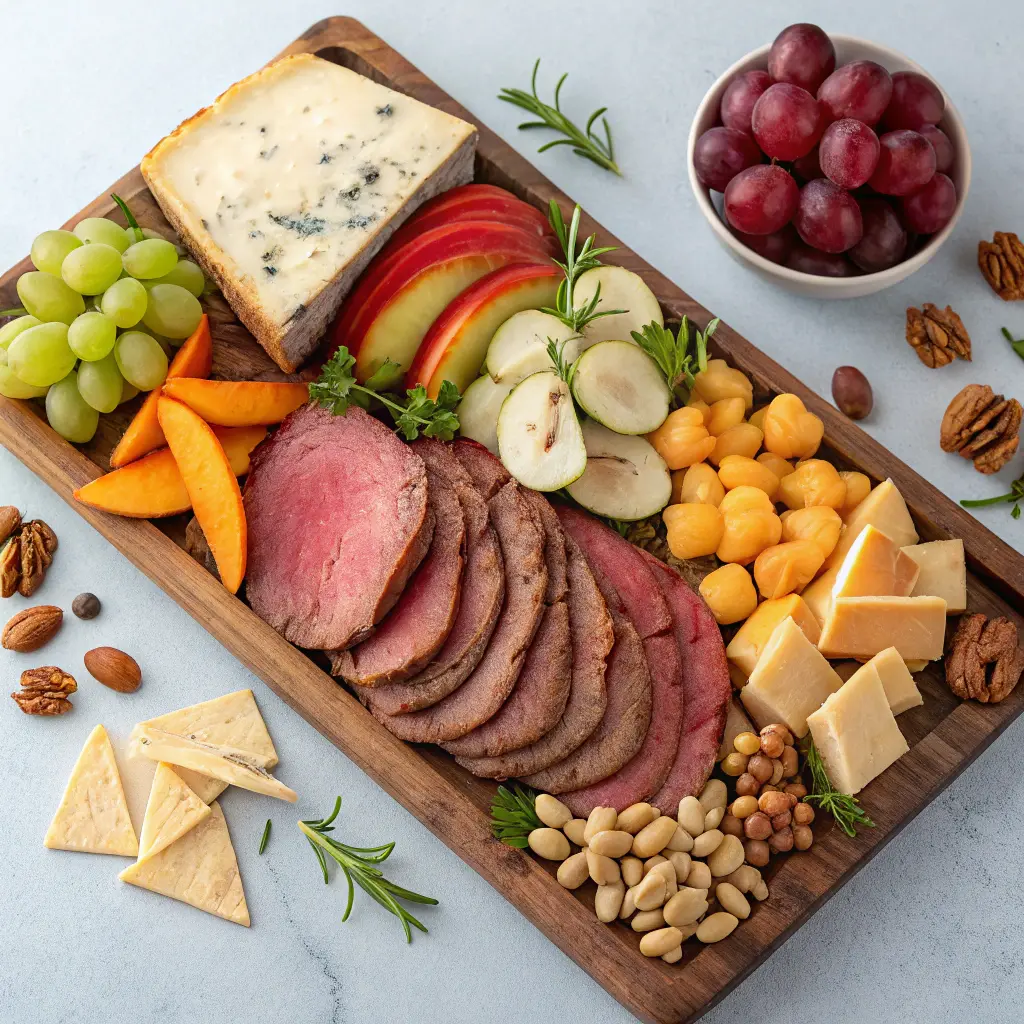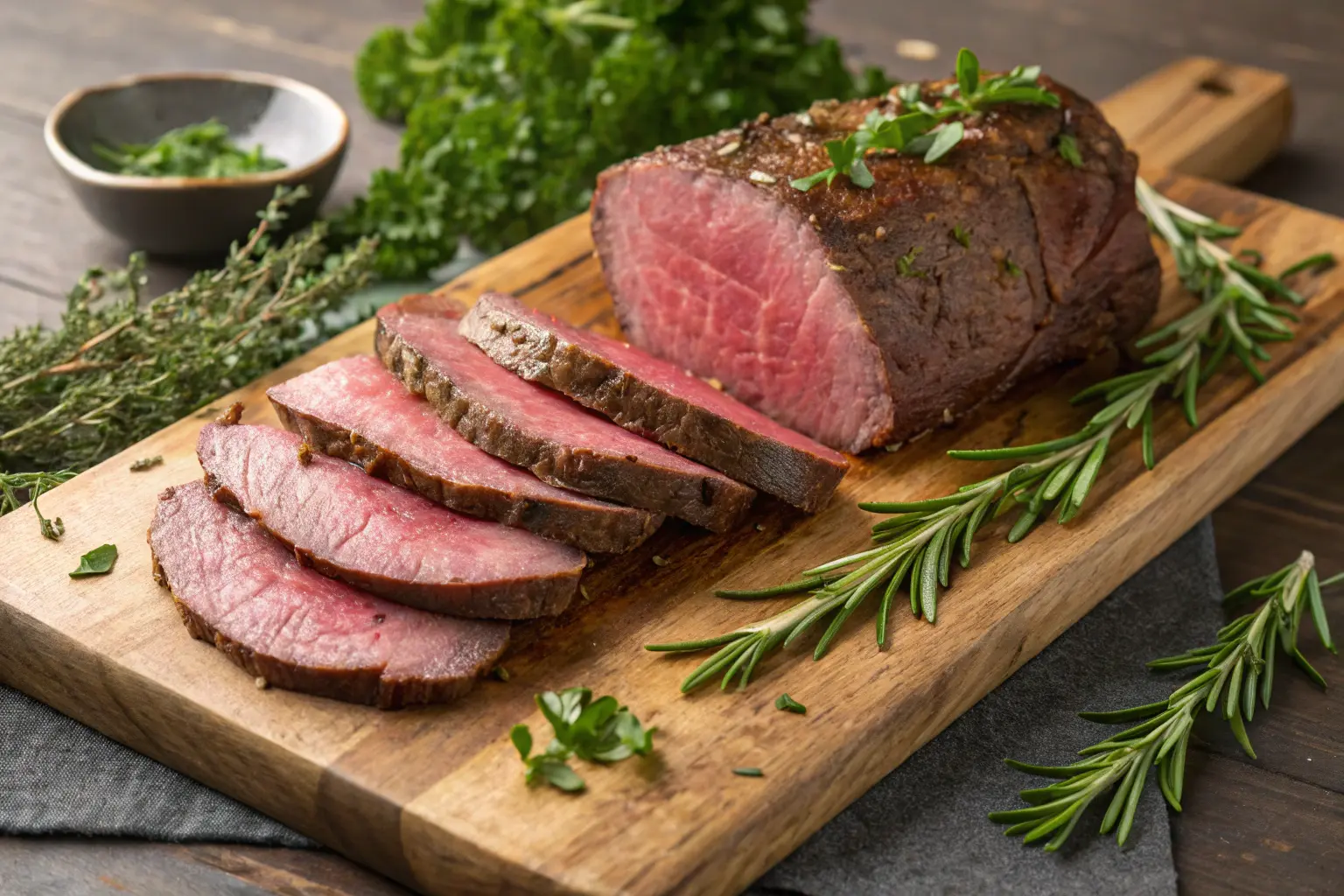Introduction
Deli meats whole roast beef is a staple in many kitchens and a favorite choice for sandwiches, wraps, and charcuterie boards. Its rich flavor, tender texture, and high protein content make it a satisfying and versatile option for quick meals and gourmet creations. Whether enjoyed in a classic roast beef sandwich, paired with artisan cheeses, or served warm with savory sauces, this deli meat stands out for its taste and quality.
Beyond its delicious flavor, deli meats whole roast beef offers a balance of protein and essential nutrients, making it a great choice for those seeking a filling yet nutritious option. Choosing the right cut, understanding its processing, and learning the best ways to store and serve it can enhance the overall experience. This guide explores everything you need to know about selecting, preparing, and enjoying deli meats whole roast beef.
What Makes Deli Meats Whole Roast Beef a Top Choice

Deli meats whole roast beef stands out for its rich, bold flavor and tender texture. It is a preferred option for those who appreciate high-quality cuts of beef that deliver both taste and nutritional benefits. Unlike processed cold cuts, whole roast beef is typically made from a single cut of beef, offering a more natural and authentic meaty experience. The quality of deli roast beef depends on the cut, preparation method, and how it is stored and served. Understanding these factors helps in making an informed choice when selecting the best whole roast beef for your meals.
Understanding the Cuts of Whole Roast Beef
The quality and texture of deli meats whole roast beef largely depend on the cut of beef used. Different cuts bring unique characteristics to the final product.
- Top Round Roast – One of the most common cuts for deli roast beef, the top round comes from the rear leg of the cow. It is lean and firm yet flavorful, making it ideal for slicing thinly for sandwiches. It is often preferred for its balance between tenderness and chewiness.
- Bottom Round Roast – Slightly tougher than the top round, the bottom round requires slow roasting to break down the muscle fibers. It is a budget-friendly option but still delivers a deep beefy flavor when prepared correctly.
- Sirloin Tip Roast – A more tender cut than the rounds, sirloin tip roast comes from the hindquarter. It has a slightly more pronounced beef flavor and a firmer texture, making it an excellent choice for those who prefer a heartier bite.
Choosing the right cut depends on personal preference. Some people enjoy a leaner, firmer bite, while others opt for more marbling and tenderness. Knowing the cut helps in selecting the right deli roast beef that aligns with your taste and texture preferences.
How Deli Roast Beef is Processed and Preserved
The preparation method plays a crucial role in the final taste and texture of deli meats whole roast beef. Unlike highly processed meats, whole roast beef is typically made using traditional cooking techniques that enhance its natural flavor.
- Oven-Roasted – This method involves slow-roasting the beef at a controlled temperature to preserve tenderness while developing a rich, roasted flavor. Oven-roasting helps retain the natural juices, keeping the meat moist and flavorful.
- Smoked – Some deli roast beef varieties are smoked to enhance flavor. Smoking uses wood chips to infuse the beef with a deep, smoky taste, making it a favorite for those who enjoy a bold and distinctive flavor profile.
- Cured or Brined – Some roast beef products are brined with seasonings and curing agents to enhance preservation and flavor. However, nitrate-free and preservative-free options are gaining popularity as healthier choices.
When selecting deli roast beef, it’s important to check the ingredient list. Many premium brands offer nitrate-free, preservative-free, and minimally processed options, which help retain the natural taste of beef without added chemicals.
Comparing Deli Meats Whole Roast Beef with Other Deli Meats
Deli roast beef is often compared to other popular deli meats, including turkey, ham, and pastrami. While each has its unique flavor and texture, roast beef stands out for its richness, high protein content, and lower carbohydrate levels.
- Roast Beef vs. Turkey – Turkey is a leaner option with lower fat and calories, making it a great choice for those watching their calorie intake. However, roast beef provides more iron and a stronger, meaty flavor.
- Roast Beef vs. Ham – Ham tends to be higher in sodium due to the curing process. While ham offers a sweet and savory taste, roast beef is often preferred for its natural beefy flavor and lower sodium content in unprocessed varieties.
- Roast Beef vs. Pastrami – Pastrami is a seasoned and smoked version of beef, usually made from brisket or navel cuts. While pastrami has a bold, peppery flavor, roast beef is typically milder and more versatile for different recipes.
When choosing between different deli meats, factors such as protein levels, sodium content, preservatives, and personal taste preferences should be considered. Deli meats whole roast beef remains a superior choice for those looking for a protein-packed, flavorful, and versatile deli option.
How to Choose the Best Deli Meats Whole Roast Beef

Selecting high-quality deli meats whole roast beef ensures better taste, texture, and nutritional value. With so many options available, understanding what makes a good roast beef is essential. Factors such as sourcing, ingredients, and storage all play a role in maintaining freshness and flavor. Choosing wisely helps in getting the best experience from this deli meat.
Key Factors to Look for in High-Quality Whole Roast Beef
The best deli meats whole roast beef starts with high-quality beef. Choosing grass-fed, organic, and minimally processed options leads to better flavor and improved nutritional benefits.
- Grass-Fed vs. Grain-Fed – Grass-fed beef is generally leaner and contains higher levels of omega-3 fatty acids and antioxidants. It provides a richer, more natural beef flavor. Grain-fed beef tends to have more marbling, making it slightly more tender and juicy.
- Organic and Nitrate-Free Options – Organic beef is raised without synthetic hormones and antibiotics, making it a healthier option. Nitrate-free deli meats avoid artificial preservatives, reducing potential health risks.
- Checking for Freshness – Look for deli roast beef with a deep red or pink color, depending on processing methods. Avoid any meat with excessive moisture, slimy texture, or an overly strong smell.
- Marbling and Texture – Slight marbling enhances flavor and juiciness. However, excessive fat or tough connective tissue may indicate a lower-quality cut. The best deli roast beef has a firm yet tender texture when sliced.
- Minimal Ingredients – Quality roast beef should have simple ingredients, including beef, salt, pepper, and natural seasonings. Avoid products with excessive artificial additives, fillers, or excessive sodium.
Reading labels carefully ensures that you get the freshest, healthiest, and most flavorful deli meats whole roast beef.
Best Brands for Deli Meats Whole Roast Beef
Many brands offer premium whole roast beef, but not all are created equal. Some focus on all-natural ingredients and minimal processing, while others prioritize affordability. Here’s a look at some of the most well-known brands:
- Boar’s Head – A widely trusted brand known for its premium quality and preservative-free options. Their roast beef is made from top round cuts and is often gluten-free with no artificial flavors.
- Applegate – Specializes in organic and grass-fed deli meats. Their roast beef is nitrate-free and minimally processed, making it a healthier choice.
- Dietz & Watson – Offers a variety of roast beef options, including herb-crusted and low-sodium versions. Their products focus on bold flavors and high-quality ingredients.
- Wellshire Farms – Known for natural and antibiotic-free meats, Wellshire provides roast beef options that are free from nitrates and artificial preservatives.
- 365 by Whole Foods Market – A good budget-friendly option that still prioritizes natural ingredients and decent quality.
When choosing a brand, consider price, quality, and availability. Some premium brands may be more expensive but offer better ingredients and healthier processing methods.
The Best Way to Store and Preserve Roast Beef
Proper storage helps maintain the flavor, texture, and freshness of deli meats whole roast beef. Whether buying in bulk or storing leftovers, following best practices ensures that the meat remains safe to eat.
- Refrigeration – Store sliced roast beef in an airtight container or vacuum-sealed bag at or below 40°F (4°C). Consume within 3 to 5 days for the best taste and quality.
- Vacuum Sealing – Extends freshness by reducing exposure to air and moisture. Vacuum-sealed roast beef can last up to 2 weeks in the refrigerator without losing flavor.
- Freezing – If not consuming within a few days, freeze roast beef in portion-sized packs. Wrap in plastic wrap, aluminum foil, or freezer-safe bags to prevent freezer burn. Properly stored, frozen deli roast beef can last up to 3 months.
- Thawing and Reheating – For best results, thaw frozen roast beef in the refrigerator overnight. To warm it up, use a low-temperature oven or steam heating to prevent it from drying out.
By following proper storage techniques, deli meats whole roast beef retains its flavor, quality, and safety for longer, ensuring a great eating experience every time.
Enjoying Deli Meats Whole Roast Beef – Serving and Pairing Ideas

Deli meats whole roast beef is not only a staple for sandwiches but also a versatile ingredient that can be used in various meals. Whether served in a sandwich, as part of a charcuterie board, or in a warm dish, roast beef adds a rich, savory flavor to any meal. Exploring different serving and pairing options helps enhance the taste and experience of enjoying this premium deli meat.
Delicious Sandwich and Wrap Ideas
A classic roast beef sandwich is a timeless favorite, but the right bread and toppings can take it to the next level.
- Traditional Roast Beef Sandwich – Layer thinly sliced deli roast beef on a crusty baguette, ciabatta, or rye bread. Add toppings like Swiss cheese, caramelized onions, and horseradish mayo for a flavorful bite.
- Hearty Whole Wheat Wrap – For a healthier option, use a whole wheat or spinach wrap and fill it with roast beef, fresh greens, cherry tomatoes, and Greek yogurt dressing.
- Low-Carb Lettuce Wrap – Swap bread for lettuce leaves to make a gluten-free and keto-friendly option. Fill it with roast beef, avocado slices, and mustard for a light yet satisfying meal.
- Open-Faced Roast Beef Melt – Toast a slice of sourdough bread, layer it with roast beef, and top with cheddar or provolone cheese, then broil until melted. Garnish with fresh arugula or pickles for added texture.
Pairing the right condiments, such as horseradish sauce, Dijon mustard, or aioli, enhances the overall flavor. Whether opting for a classic sandwich or a wrap, deli meats whole roast beef remains the star ingredient.
Using Deli Meats Whole Roast Beef in Charcuterie Boards
Deli roast beef makes an excellent addition to a charcuterie board, offering a bold, meaty contrast to other flavors. The key is balancing textures and tastes with complementary pairings.
- Cheese Pairings – Rich, creamy cheeses like brie, blue cheese, gouda, or sharp cheddar complement the deep, savory taste of roast beef.
- Nut Selection – Walnuts, pecans, and almonds provide a crunchy contrast to the soft texture of roast beef.
- Fruit Additions – Sliced pears, grapes, or figs add a natural sweetness that balances the saltiness of the meat.
- Spreads and Condiments – Whole grain mustard, fig jam, and roasted red pepper hummus enhance the taste profile of the board.
- Bread and Crackers – Offer a mix of artisan crackers, crostini, and sourdough slices to pair with roast beef and spreads.
For an enhanced experience, serve the charcuterie board with red wine (such as Cabernet Sauvignon or Merlot), craft beer, or sparkling water to complement the flavors of the deli meats whole roast beef.
Cooking with Whole Roast Beef Beyond Sandwiches
Deli meats whole roast beef is more than just a sandwich filler. It can be incorporated into warm dishes, salads, and even breakfast options.
- Roast Beef Salad – Toss sliced roast beef with mixed greens, cherry tomatoes, blue cheese crumbles, and balsamic vinaigrette for a protein-packed salad.
- Beef Stir-Fry – Add strips of roast beef to a stir-fry with bell peppers, onions, and soy sauce for a quick and flavorful meal.
- Cheesy Roast Beef Casserole – Layer roast beef with mashed potatoes, cheddar cheese, and caramelized onions, then bake for a comforting dish.
- Breakfast Hash – Sauté roast beef with potatoes, onions, and bell peppers, then top with a fried egg for a delicious morning meal.
- Roast Beef Quesadilla – Fill a flour tortilla with roast beef, Monterey Jack cheese, and caramelized onions, then grill until crispy.
Leftover deli roast beef can be repurposed into soups, pasta dishes, or even homemade beef tacos. Its versatility allows for creative cooking, making it a valuable ingredient in the kitchen.
By exploring different ways to serve and enjoy deli meats whole roast beef, you can make the most of this flavorful and protein-rich option, whether in a simple sandwich or an elaborate meal.
Conclusion
Deli meats whole roast beef is a flavorful, protein-rich option that enhances a variety of meals, from classic sandwiches to gourmet charcuterie boards and warm dishes. Its tender texture, deep beefy flavor, and high nutritional value make it a standout choice among deli meats. Whether choosing a lean top round cut, a marbled sirloin tip, or a smoked variety, selecting high-quality roast beef ensures a superior dining experience.
By experimenting with different cuts, brands, and serving ideas, you can discover new ways to enjoy deli roast beef while making the most of its versatility and taste. Opting for organic, nitrate-free, and minimally processed options further enhances both health benefits and flavor.
When selecting deli meats whole roast beef, paying attention to quality, storage methods, and ingredient transparency ensures freshness and taste. Whether served in a sandwich, paired with gourmet cheeses, or incorporated into creative dishes, roast beef remains a timeless and satisfying choice for meat lovers.

